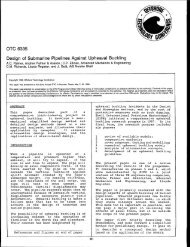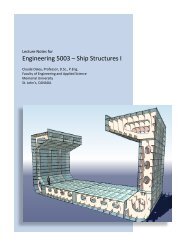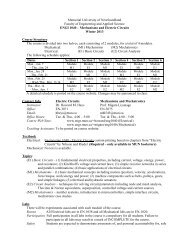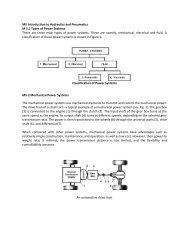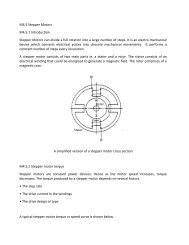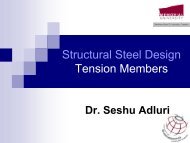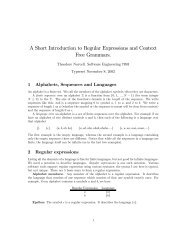Measurement of Horizontal and Vertical Angle - Memorial University ...
Measurement of Horizontal and Vertical Angle - Memorial University ...
Measurement of Horizontal and Vertical Angle - Memorial University ...
You also want an ePaper? Increase the reach of your titles
YUMPU automatically turns print PDFs into web optimized ePapers that Google loves.
ENGI3703- Surveying <strong>and</strong> Geomatics Fall 2007<br />
Lab 3: <strong>Measurement</strong> <strong>of</strong> <strong>Horizontal</strong> <strong>and</strong> <strong>Vertical</strong> <strong>Angle</strong><br />
Objective: To motivate the students to use the techniques <strong>and</strong> present the concepts <strong>of</strong> angles<br />
<strong>and</strong> coordinates.<br />
Preparation: Read chapter 8 in the Elementary Surveying, 11 th ed. Textbook.<br />
Overview: Determining the relative position <strong>of</strong> points <strong>of</strong>ten involves measurements <strong>of</strong> both<br />
angles <strong>and</strong> distances. Therefore it is necessary to measure angles to a relatively<br />
high level <strong>of</strong> accuracy.<br />
Instruments to be used: Check out the following equipment:<br />
Procedure:<br />
<strong>Memorial</strong> <strong>University</strong> <strong>of</strong> Newfoundl<strong>and</strong><br />
1. Transit or repeating Theodolite<br />
2. Tripod<br />
3. Two range poles<br />
4. Five pegs<br />
5. Plumb bobs<br />
1. Students are divided into groups. Each group does the prescribed exercise.<br />
Each student records his/her own measurements in his/her field book.<br />
2. Lab instructor will demonstrate setup <strong>and</strong> operation <strong>of</strong> the theodolite.<br />
3. Using the provided transit or theodolite set up the instrument over a point<br />
(assigned by the instructor). Choose four other different points around 360 0<br />
sweep. Use one <strong>of</strong> the chosen points as starting point (as a reference).<br />
4. Measure <strong>and</strong> record the clockwise horizontal angles between the reference<br />
point <strong>and</strong> the other three chosen points with the provided instrument. Make<br />
one set <strong>of</strong> measurements with normal scope position <strong>and</strong> another one with<br />
turned over (‘Plunged’) position.<br />
5. Follow these steps when turning each horizontal angle:<br />
a. Allow two persons at both the backsight point <strong>and</strong> foresight point to<br />
hold the range poles above the chosen points.<br />
b. Set the horizontal circle to 0º 00’ 00”<br />
• For initial setup, align the upper motion mark <strong>and</strong><br />
intermediate plate mark. While looking through the reading<br />
sight, slowly adjust the plate until the view reads zero (see<br />
illustration below). Lock the upper motion <strong>and</strong> adjust by<br />
rotating the upper motion adjustment dial.<br />
1
ENGI3703- Surveying <strong>and</strong> Geomatics Fall 2007<br />
Classroom work:<br />
<strong>Memorial</strong> <strong>University</strong> <strong>of</strong> Newfoundl<strong>and</strong><br />
c. Sight the backsight using the LOWER MOTION<br />
• Lock the Lower motion <strong>and</strong> adjust until the vertical crosshair<br />
splits the string line <strong>of</strong> your rodperson.<br />
d. Turn to the foresight using the UPPER MOTION<br />
• Unlock the upper motion <strong>and</strong> advance to your foresight point.<br />
Use the lock <strong>and</strong> adjustment on the upper motion only.<br />
e. Record horizontal angle to the nearest ¼ minute (15”)<br />
f. Turn the telescope in “Plunged” position <strong>and</strong> backsight using the<br />
LOWER MOTION<br />
• Unlock the lower motion <strong>and</strong> turn back to your backsight<br />
point. Lock <strong>and</strong> adjust using only the lower motion. You will<br />
notice your reading will not change during this step.<br />
g. Turn to the foresight again using the UPPER MOTION, using the<br />
same instructions as before to turn to the foresight point.<br />
h. Record second horizontal angle, which should be double the first<br />
angle.<br />
i. Divide the second reading by two (2) <strong>and</strong> compare with the first<br />
reading (should be within 30” <strong>of</strong> the first reading)<br />
6. Choose a point situated well above the ground <strong>and</strong> with the transit or with the<br />
theodolite measure the vertical angle between the horizontal plane <strong>and</strong> the top<br />
<strong>of</strong> the confederation building.<br />
Note:<br />
♦ Make it sure the instrument is leveled properly before measurements.<br />
♦ Original measurements are to be documented (including a sketch) in the<br />
field book.<br />
1. Calculate the sum <strong>of</strong> all angles, <strong>and</strong> check against 360 0 .<br />
2. Summarize your data <strong>and</strong> provide average angles measured with the<br />
instrument by you <strong>and</strong> by other members <strong>of</strong> your group.<br />
3. Evaluate your results by comparing the average angle obtained by your group<br />
members.<br />
4. Evaluate the errors you may have committed during measurements.<br />
2
ENGI3703- Surveying <strong>and</strong> Geomatics Fall 2007<br />
<strong>Memorial</strong> <strong>University</strong> <strong>of</strong> Newfoundl<strong>and</strong><br />
3





